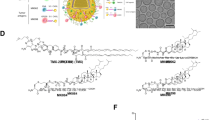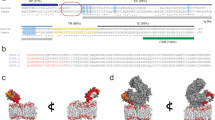Abstract
T cells responsive to minor histocompatibility (H) antigens are extremely effective in curing leukemia but it remains unknown whether they can eradicate solid tumors. We report that injection of CD8+ T cells primed against the immunodominant H7a minor H antigen can cure established melanomas in mice. Tumor rejection was initiated by preferential extravasation at the tumor site of interferon (IFN)-γ–producing H7a-specific T cells. Intratumoral release of IFN-γ had two crucial effects: inhibition of tumor angiogenesis and upregulation of major histocompatibility complex (MHC) class I expression on tumor cells. Despite ubiquitous expression of H7a, dissemination of a few H7a-specific T cells in extralymphoid organs caused neither graft-versus-host disease (GVHD) nor vitiligo because host nonhematopoietic cells were protected by their low expression of MHC class I. Our preclinical model yields unique insights into how minor H antigen–based immunotherapy could be used to treat human solid tumors.
This is a preview of subscription content, access via your institution
Access options
Subscribe to this journal
Receive 12 print issues and online access
$209.00 per year
only $17.42 per issue
Buy this article
- Purchase on Springer Link
- Instant access to full article PDF
Prices may be subject to local taxes which are calculated during checkout






Similar content being viewed by others
References
Finn, O.J. Cancer vaccines: between the idea and the reality. Nat. Rev. Immunol. 3, 630–641 (2003).
Rosenberg, S.A., Yang, J.C. & Restifo, N.P. Cancer immunotherapy: moving beyond current vaccines. Nat. Med. 10, 909–915 (2004).
Bleakley, M. & Riddell, S.R. Molecules and mechanisms of the graft-versus-leukaemia effect. Nat. Rev. Cancer 4, 371–380 (2004).
Perreault, C. & Brochu, S. Adoptive cancer immunotherapy: discovering the best targets. J. Mol. Med. 80, 212–218 (2002).
Molldrem, J.J. et al. Evidence that specific T lymphocytes may participate in the elimination of chronic myelogenous leukemia. Nat. Med. 6, 1018–1023 (2000).
Fontaine, P. et al. Adoptive transfer of T lymphocytes targeted to a single immunodominant minor histocompatibility antigen eradicates leukemia cells without causing graft-versus-host disease. Nat. Med. 7, 789–794 (2001).
Meunier, M.C., Roy-Proulx, G., Labrecque, N. & Perreault, C. Tissue distribution of target antigen has a decisive influence on the outcome of adoptive cancer immunotherapy. Blood 101, 766–770 (2003).
Bevan, M.J. Helping the CD8+ T-cell response. Nat. Rev. Immunol. 4, 595–602 (2004).
Pion, S. et al. On the mechanisms of immunodominance in cytotoxic T lymphocyte responses to minor histocompatibility antigens. Eur. J. Immunol. 27, 421–430 (1997).
Roy-Proulx, G., Meunier, M.C., Lanteigne, A.M., Brochu, S. & Perreault, C. Immunodomination results from functional differences between competing CTL. Eur. J. Immunol. 31, 2284–2292 (2001).
Eden, P.A. et al. Biochemical and immunogenetic analysis of an immunodominant peptide (B6dom1) encoded by the classical H7 minor histocompatibility locus. J. Immunol. 162, 4502–4510 (1999).
Rubio, V. et al. Ex vivo identification, isolation and analysis of tumor-cytolytic T cells. Nat. Med. 9, 1377–1382 (2003).
Harrington, L.E., Galvan, M., Baum, L.G., Altman, J.D. & Ahmed, R. Differentiating between memory and effector CD8 T cells by altered expression of cell surface O-glycans. J. Exp. Med. 191, 1241–1246 (2000).
von Andrian, U.H. & Mackay, C.R. T-cell function and migration. Two sides of the same coin. N. Engl. J. Med. 343, 1020–1034 (2000).
Issekutz, A.C. & Issekutz, T.B. The role of E-selectin, P-selectin, and very late activation antigen-4 in T lymphocyte migration to dermal inflammation. J. Immunol. 168, 1934–1939 (2002).
Thatte, J., Dabak, V., Williams, M.B., Braciale, T.J. & Ley, K. LFA-1 is required for retention of effector CD8 T cells in mouse lungs. Blood 101, 4916–4922 (2003).
Dunn, G.P., Old, L.J. & Schreiber, R.D. The immunobiology of cancer immunosurveillance and immunoediting. Immunity 21, 137–148 (2004).
Spiotto, M.T., Rowley, D.A. & Schreiber, H. Bystander elimination of antigen loss variants in established tumors. Nat. Med. 10, 294–298 (2004).
Griem, P. et al. Uneven tissue distribution of minor histocompatibility proteins versus peptides is caused by MHC expression. Cell 65, 633–640 (1991).
Schroder, K., Hertzog, P.J., Ravasi, T. & Hume, D.A. Interferon-γ: an overview of signals, mechanisms and functions. J. Leukoc. Biol. 75, 163–189 (2004).
Schüler, T. & Blankenstein, T. Cutting edge: CD8+ effector T cells reject tumors by direct antigen recognition but indirect action on host cells. J. Immunol. 170, 4427–4431 (2003).
Ogasawara, K. et al. NKG2D blockade prevents autoimmune diabetes in NOD mice. Immunity 20, 757–767 (2004).
Wang, T. et al. Regulation of the innate and adaptive immune responses by Stat-3 signaling in tumor cells. Nat. Med. 10, 48–54 (2004).
Butcher, E.C. & Picker, L.J. Lymphocyte homing and homeostasis. Science 272, 60–66 (1996).
Siegelman, M.H., Stanescu, D. & Estess, P. The CD44-initiated pathway of T-cell extravasation uses VLA-4 but not LFA-1 for firm adhesion. J. Clin. Invest. 105, 683–691 (2000).
Nandi, A., Estess, P. & Siegelman, M. Bimolecular complex between rolling and firm adhesion receptors required for cell arrest; CD44 association with VLA-4 in T cell extravasation. Immunity 20, 455–465 (2004).
Kuzu, I., Bicknell, R., Fletcher, C.D. & Gatter, K.C. Expression of adhesion molecules on the endothelium of normal tissue vessels and vascular tumors. Lab. Invest. 69, 322–328 (1993).
Dienst, A. et al. Specific occlusion of murine and human tumor vasculature by VCAM-1-targeted recombinant fusion proteins. J. Natl. Cancer Inst. 97, 733–747 (2005).
Byrne, G.J. et al. Serum soluble vascular cell adhesion molecule-1: role as a surrogate marker of angiogenesis. J. Natl. Cancer Inst. 92, 1329–1336 (2000).
Amatschek, S. et al. Tissue-wide expression profiling using cDNA subtraction and microarrays to identify tumor-specific genes. Cancer Res. 64, 844–856 (2004).
Gervois, N., Guilloux, Y., Diez, E. & Jotereau, F. Suboptimal activation of melanoma infiltrating lymphocytes (TIL) due to low avidity of TCR/MHC-tumor peptide interactions. J. Exp. Med. 183, 2403–2407 (1996).
Hernandez, J., Lee, P.P., Davis, M.M. & Sherman, L.A. The use of HLA A2.1/p53 peptide tetramers to visualize the impact of self tolerance on the TCR repertoire. J. Immunol. 164, 596–602 (2000).
Yoshimura, Y. et al. Duration of alloantigen presentation and avidity of T cell antigen recognition correlate with immunodominance of CTL response to minor histocompatibility antigens. J. Immunol. 172, 6666–6674 (2004).
Li, Y. et al. Directed evolution of human T-cell receptors with picomolar affinities by phage display. Nat. Biotechnol. 23, 349–354 (2005).
Morgan, R.A. et al. High efficiency TCR gene transfer into primary human lymphocytes affords avid recognition of melanoma tumor antigen glycoprotein 100 and does not alter the recognition of autologous melanoma antigens. J. Immunol. 171, 3287–3295 (2003).
Korngold, R., Leighton, C., Mobraaten, L.E. & Berger, M.A. Inter-strain graft-vs.-host disease T-cell responses to immunodominant minor histocompatibility antigens. Biol. Blood Marrow Transplant. 3, 57–64 (1997).
Klein, C.A. et al. The hematopoietic system-specific minor histocompatibility antigen HA-1 shows aberrant expression in epithelial cancer cells. J. Exp. Med. 196, 359–368 (2002).
Spierings, E., Wieles, B. & Goulmy, E. Minor histocompatibility antigens - big in tumour therapy. Trends Immunol. 25, 56–60 (2004).
de Bueger, M., Bakker, A., Van Rood, J.J., van der Woude, F. & Goulmy, E. Tissue distribution of human minor histocompatibility antigens. Ubiquitous versus restricted tissue distribution indicates heterogeneity among human cytotoxic T lymphocyte-defined non-MHC antigens. J. Immunol. 149, 1788–1794 (1992).
Liu, L. et al. Visualization and quantification of T cell-mediated cytotoxicity using cell-permeable fluorogenic caspase substrates. Nat. Med. 8, 185–189 (2002).
Acknowledgements
This work was supported by Grant 014271 (to C.P.) from the National Cancer Institute of Canada. M.-C.M. is supported by a training grant from the National Cancer Institute of Canada. J.-S.D. is supported by a training grant from the Fonds de la Recherche en Santé du Québec. C.P. holds a Canada Research Chair in Immunobiology. We thank J.A. Kashul for editorial assistance.
Author information
Authors and Affiliations
Corresponding author
Ethics declarations
Competing interests
The authors declare no competing financial interests.
Supplementary information
Supplementary Fig. 1
Experimental model. (PDF 93 kb)
Supplementary Table 1
H7a genotype of mice and tumors used in this work. (PDF 37 kb)
Rights and permissions
About this article
Cite this article
Meunier, MC., Delisle, JS., Bergeron, J. et al. T cells targeted against a single minor histocompatibility antigen can cure solid tumors. Nat Med 11, 1222–1229 (2005). https://doi.org/10.1038/nm1311
Received:
Accepted:
Published:
Issue Date:
DOI: https://doi.org/10.1038/nm1311
This article is cited by
-
Identification of antigenic epitopes recognized by tumor infiltrating lymphocytes in high grade serous ovarian cancer by multi-omics profiling of the auto-antigen repertoire
Cancer Immunology, Immunotherapy (2023)
-
Bystander IFN-γ activity promotes widespread and sustained cytokine signaling altering the tumor microenvironment
Nature Cancer (2020)
-
Angiogenic factor-driven inflammation promotes extravasation of human proangiogenic monocytes to tumours
Nature Communications (2018)
-
Proteogenomic-based discovery of minor histocompatibility antigens with suitable features for immunotherapy of hematologic cancers
Leukemia (2016)
-
Expression of immunoproteasome genes is regulated by cell-intrinsic and –extrinsic factors in human cancers
Scientific Reports (2016)



